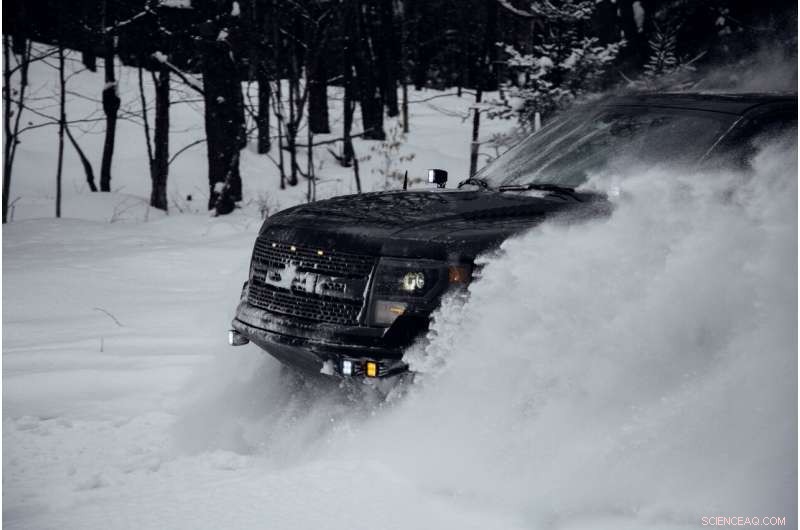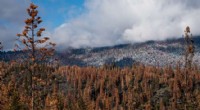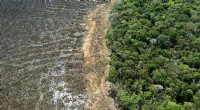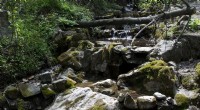Michigan vintre, som generationer har kendt dem, kan være ved at være slut

Kredit:Unsplash/CC0 Public Domain
Karl Schwartz ville ønske, at han simpelthen jagtede ære på snescooter-racerbanen. I stedet, i de seneste år, han er blevet tvunget til at jagte stadig mere uhåndgribeligt koldt vejr.
Schwartz, af Freeland, er præsident for Midwest International Racing Association, et snescooterracerkredsløb, der primært har fungeret i Michigan i mere end 40 år. Deres weekendløb trækker omkring 100 hold, hundredvis af racere og besætningsmedlemmer, og tusindvis flere fans, normalt som en del af et lokalsamfunds vinterfestival.
Men hvert år, som Michigans klimaændringer, det bliver sværere at gøre.
"Vi kører på is, ikke sne, " sagde han. "Vi har ikke brug for sne - vi har brug for kolde temperaturer."
Racerne konkurrerer ofte på hestebaner, oversvømmet med hundredtusindvis af liter vand for at forsøge at bygge en base af frossen jord, som racernes maskiner vil tygge op i løbet af en weekend med konkurrence. De har brug for omkring to ugers temperaturer i teenageårene for at skabe de rette forhold. Med stigende frekvens, det bliver næsten umuligt at finde, sagde Schwartz.
"På trods af vores bedste bestræbelser på at flytte rundt på vores kalender, og vand disse racerbaner uger i forvejen, vi skal stadig flytte datoer, aflys datoer og løb under mindre end perfekte forhold på grund af det varme vejr, " han sagde.
"Dette har været et gennemgående problem for os, især de sidste par år. Det har stået på længere end det, men især de seneste fem år, det har virkelig været, virkelig problematisk."
Væddeløbsforeningens bestyrelse har de seneste år holdt møder for at snakke om, hvad den kan, herunder at flytte flere løb længere mod nord.
"(Men) vi er allerede ved Sault Ste. Marie, "på den østlige øvre halvø ved den canadiske grænse, sagde Schwartz. "To løb der, og de kan ikke engang blive kolde nok. Vores løb i Ironwood (i det fjerne vestlige U.P.) havde problemer, også.
"Når du ikke kan få is ved den canadiske grænse, hvor meget længere nordpå kan du gå?"
Michigan er forkølet, snedækkede vintre, og en livsstil bygget op omkring dem, bliver forstyrret af klimaændringer. Og til vinterfestivaler, der er afhængige af kulde, sne og is – og samfund, der er afhængige af det økonomiske løft på et langsomt tidspunkt, som disse festivaler bringer med sig – det forårsager en del vanskeligheder med at tilpasse sig, og endda for at overleve.
De Store Søer-regionen har set en større stigning i årlige gennemsnitstemperaturer end resten af det kontinentale USA. Og "vintrene bliver hurtigere varmere end somrene er, " sagde Richard Rood, en professor i klima- og rumvidenskab og teknik ved University of Michigan.
"Planeten generelt opvarmes, men stater som Wisconsin, Michigan og Illinois bliver varmere, hurtigere, " sagde Don Wuebbles, en professor ved Institut for Atmosfæriske Videnskaber ved University of Illinois.
Snefald i Great Lakes Basin faldt 2,25 % fra 1984 til 2013 sammenlignet med 1954 til 1983. Forskere forventer, at snefald kan falde med næsten 48 % i 2080 under et business-as-usual-scenarie uden reducerede menneskelige kulstofemissioner. Men selv under et mere optimistisk scenarie, hvor udledningen af drivhusgasser er væsentligt begrænset, vintersnefald i Great Lakes Basin forventes at falde med mere end 28% i 2080.
Antallet af dage, hvor den lave temperatur falder under frysepunktet, 32 grader Fahrenheit, i Great Lakes-regionen forventes af forskere at falde med mere end en måned om året i scenariet med højere emissioner, og tre uger i scenariet med lavere emissioner. Og dage, hvor den høje temperatur forbliver under frysepunktet - den slags konsekvent kolde vinterdage, der er nødvendige for aktiviteter som snescooterkørsel, isfiskeri, langrend og mere - forventes at falde med 56 dage om året under højere kulstofemissioner, og med 31 dage under lavere emissioner.
Michigan vintre, som generationer har kendt dem og stolet på dem, ser ud til at være ved at være slut. Der vil stadig forekomme kolde snaps og tung sne-effekt, men sker i sjældnere og sjældnere udbrud over tid.
"Mens det i visse regioner stadig sner meget, hvordan den opfører sig, når den først er på jorden, er en hel del anderledes, " sagde Rood. "Det varer ikke så længe, og det bliver sjusket, når regnen falder på den.
"Det behøver ikke at være så meget varmere, at du får søeffektregn frem for søeffektsne."
Ved slutningen af århundredet, under et scenarie med fortsat høje kulstofemissioner, forskere regner med, at Michigans årlige gennemsnitstemperatur kan stige med 9 eller 10 grader Fahrenheit, sagde Wuebbles.
"Det er meget, meget anderledes klima, sagde han. Til sammenligning, den sidste istid, som bragte is 2 miles tyk her, temperaturen var 11 grader køligere end i dag."
Vinterfesten er aflyst – igen
Michigans vinterfestivaler står over for en anden udfordring i år - COVID-19-pandemien. Men i de senere år, forstyrrelser er kommet fra mangel på traditionelle vinterforhold.
Caro Vinterfest, i Thumb-regionen på Michigan's Lower Peninsula, aflyste arrangementer for anden vinter i træk i januar. Festivalen er bygget op omkring Midwest International Racing Associations snescooterløb.
"De sidste par år, temperaturerne har overhovedet ikke samarbejdet før begivenheden, " said Kris Reinelt, Caro Winter Fest board president.
Festival staff usually begin flooding the Tuscola County Fairgrounds to build ice layers for the snowmobile racing track after the holidays, in preparation for the Winter Fest races, usually held around the third weekend of January.
"We need at least a week of consistent, low temperatures, " Reinelt said. "We would be able to build up 1 or 2 inches of ice a night, but then in the daytime, it would warm up and take it away.
"We have to pay for the water, we have to pay for the time. It doesn't become cost-effective to fight that battle."
The lost festivals over back-to-back years, and threatened again in 2021 by the coronavirus, cause a painful economic hit for the community.
"The racing teams bring in 300 people just among the racers, their families and friends who follow them, " Reinelt said. "In Caro, we draw another 3, 000 mennesker. Those are 3, 300 people who may never come to Caro, and they are coming in the middle of winter, which is a slow time. That's so helpful to the hotels, restauranter, grocery stores."
At Tip-Up Town U.S., Michigan's longest-running winter festival, established in 1953 and built around ice fishing on Houghton Lake, nearly a dozen people fell through the ice last January, their snowmobiles, four-wheelers and other vehicles breaking through thin ice that was open water less than a week earlier.
The Kalkaska Winterfest, in northern Lower Michigan, features one of the Midwest's largest dog-sledding sprint races, going back to 1965—longer-running than the famed Iditarod in Alaska.
I 2017 the races scheduled for January were postponed until the first week of March because of a lack of wintry conditions. When it was more of the same in March, the races were canceled.
I 2018, the races were postponed in January, then canceled in February. Det næste år, the January dates were again moved to February, when the latter half of the racing schedule that weekend was canceled because "everything had just melted, " said Shannon Moore, a race marshal and board secretary for the Winterfest.
"That was something I'd never seen at a dog race, ever, " hun sagde.
At the local hotel sponsoring the event and hosting race teams and their families, the All Season Resort, "they go from being completely booked to 5% occupancy when we cancel, " sagde Moore.
Many of the dog-sledding teams come from out of state, as much as 10 hours away, and bring kennels and trucks, crews and families. Though 2020's races went off without a hitch in mid-February, the more races that get postponed, canceled or happen in poor conditions, the more worry that teams won't bother coming, sagde Moore.
"I think we'll have to keep aiming for February and hoping we get lucky, " she said. "When we do it later in March, det kommer ikke til at virke. And the January dates haven't been working, enten."
Snowmobile sales plummet 70%
Carl Gerstacker was a snowmobiling fanatic.
"From the mid-'90s until about '05-'06, there was a solid 10 years where we put on just a ton of miles and had fun with it, " han sagde.
But the pastime got more expensive. And the right conditions became harder to find.
"The winters are hit-or-miss now, " he said. "We've had some really good winters, where the guys are up there (in northern Michigan) feasting on perfect conditions. But when you're making payments on a $15, 000 machine, you need some consistency."
Gerstacker and his friends were "weekend warriors"—"get off work a little early on Friday, head north, spend the weekend riding the trails, head back home Sunday and go to work on Monday." But needing to go ever farther north to find the best, most consistent riding became a time-consuming, costly effort.
"If you're chasing snow into the U.P., that's not an option anymore, " the Brighton-area resident said. "You're talking eight to 10 hours of driving to get up into the good snow and the best trails."
Gerstacker in recent years has changed out the sleds for a side-by-side, a four-wheeled recreational vehicle featuring two rows of seating that his wife and two children can enjoy with him.
"There's always dirt, there's not always snow, " he said. "I'm watching my buddies making payments on these (snowmobiles), and they are going to ride two months this year. And these quick little shots Up North are expensive, også.
"I don't look back. I enjoy the side-by-side more than I ever did snowmobiling."
Gerstacker isn't alone in leaving snowmobiles behind. Snowmobile sales in the U.S. are down 70% from their 1997 peak, according to the International Snowmobile Manufacturers Association, a Haslett-based trade organization representing North America's four major snowmobile manufacturers:Arctic Cat; Ski-Doo/Bombardier; Polaris and Yamaha.
The Michigan Snowmobile Association, a Wyoming, Michigan-based nonprofit organization promoting and preserving the sport, also saw the changing reality. I maj 2019, its board—over the protests of some sledding die-hards—voted to become the Michigan Snowmobile and ORV Association, adding off-road vehicles under its canopy.
"They are motorized, we are motorized, and very often we have the same goals and objectives, " such as promoting trail access, said Karen Middendorp, the association's executive director.
Changing weather is unquestionably a factor in snowmobiling's decline, hun sagde.
"You can't ride every weekend, especially for the down-staters, " she said. "There's not enough snow."
Snowmobiling exploded in popularity in the mid-1990s to mid-2000s, bringing $321 million in sales, $187 million in income, and more than 6, 000 jobs to Michigan's economy, according to a 1998 Michigan State University study. It was primarily driven by baby boomers who had reached a more comfortable point in their lives and had the disposable income to afford, and the time to enjoy, snowmobiling. But now that population cohort is waning in the sport, said Edward Klim, executive director of the snowmobile manufacturers association.
"We have started to really look at millennials and Generation X. Are they recreating in the snow? Are they riding snowmobiles?" han sagde. "How does the next generation want to recreate? Some people will buy an ATV or UTV (utility terrain vehicle) and use it nine or 10 months a year."
It's a reality snowmobile dealers have been forced to confront:change or die.
"The writing was on the wall 10-plus years ago, " said Mike Nord, owner of Nord-Ride Motorsports in Mount Morris Township.
Around 2000, there were as many as 10 snowmobile dealerships in the greater Genesee County area. Nord's is now the only one left.
"There are two negative things against it:The cost of it now, and the weather, " he said. "The dealers had to look at it and say, 'This isn't a good business decision any longer.'"
Nord has survived by diversifying his vehicles, adding ATVs, side-by-sides and more. But even that comes with risks.
"If you look at some of the dealers that have fallen by the wayside, they fell into this trap, " he said. "You have to be able to accommodate (these diverse recreational vehicles), so you have to get bigger on your buildings, and that means bigger on your overheads. You finance that to increase the size of your building, and all of a sudden, we have an economic downturn. There is no Plan B."
I modsætning, ski resorts have stayed relatively unscathed by warming weather because of their ability to make snow, said Amy Reents, executive director of the Midwest Ski Areas Association based in Hastings, Minnesota, a nonprofit trade group promoting skiing and ski resort interests in Michigan and surrounding states.
"We're not growing by leaps and bounds, but there haven't been any great fall-offs, " hun sagde.
During a few days of cold weather, a ski resort can lay down several feet of manufactured snow, hun sagde. It's then packed and groomed and provides a base with its own refrigeration.
"They can withstand several days in the 40s—it will do much better than the snow in your front yard, " Reents said.
"The changes in snow-making technology over the years have made it so much easier to make snow in warmer temperatures. If anything has changed for the ski industry, it's that (resorts) have decided that capital investing in snow-making technology is hugely important."
Adaptation is essential
Adaptation and diversification will become increasingly essential for Michigan's winter festivals to continue and thrive. Many have already figured that out.
From long-ago years where many of Tip-Up Town U.S.'s events were held on the thick ice of Houghton Lake, the festival now largely operates under large tents on the shore, featuring family fun, mad, music and merchants, said Jay Jacobs, executive director of the Houghton Lake Chamber of Commerce and a lead organizer of the festival.
Tip-Up Town typically draws about 10, 000 visitors over its two weekends of events at the end of January.
"It's very essential to us, " he said. "We rely on tourism—we don't have an industrial park; Houghton Lake doesn't have a defined downtown, et hospital, a university. These two weekends in the winter are a nice little shot in the arm for the community."
But even with diverse events not reliant on snow, ice or cold, a psychological deterrent can keep potential festival-goers home when it's warm out.
"It does affect the number of people who show up, " said Jacobs. "We've had a few years where it's been rainy, and people just don't hang around."
The Caro Winter Fest is so intricately tied to snowmobile races, it can't happen without them right now, Reinelt said. She wants to ask residents how they feel about changing that, in the wake of the recent, weather-related cancelations.
"I want to do polls on our Facebook:Would you come out in the middle of winter to watch a chainsaw ice competition, a warming tent with live entertainment, and a beer and wine bar?" she said.
A larger adaptation is needed, Rood said:a reduction in human-caused carbon emissions that are fueling climate change.
"These big changes should be major motivators to take on that carbon dioxide reduction problem, " han sagde.
©2021 the Detroit Free Press
Distribueret af Tribune Content Agency, LLC.
 Varme artikler
Varme artikler
-
 En bedre forståelse af koralskeletets vækst foreslår måder at genoprette revEt højeffekt mikroskopisk billede af skelettet fra Turbinaria peltata viser et mønster af både ionvedhæftning (i blåt) og nanopartikelvedhæftning (i grøn) af nye mineraler til skelettet, hvilket angiv
En bedre forståelse af koralskeletets vækst foreslår måder at genoprette revEt højeffekt mikroskopisk billede af skelettet fra Turbinaria peltata viser et mønster af både ionvedhæftning (i blåt) og nanopartikelvedhæftning (i grøn) af nye mineraler til skelettet, hvilket angiv -
 Kan vores skove overleve den næste tørke?Mange træer i Sierra er døde i de sidste par år på grund af tørke. Kredit:UC Merced UC Merced-forskere har beviser for, at Californiens skove er særligt sårbare over for flerårige tørke, fordi der
Kan vores skove overleve den næste tørke?Mange træer i Sierra er døde i de sidste par år på grund af tørke. Kredit:UC Merced UC Merced-forskere har beviser for, at Californiens skove er særligt sårbare over for flerårige tørke, fordi der -
 Oprør over Brasiliens lovforslag om lempelse af miljøreglerneDette 2020-filfoto viser et skovryddet område i Brasilien, hvor lovgivere blev anklaget for yderligere at true landets forsvindende regnskove Miljøforkæmpere anklagede torsdag brasilianske lovgive
Oprør over Brasiliens lovforslag om lempelse af miljøreglerneDette 2020-filfoto viser et skovryddet område i Brasilien, hvor lovgivere blev anklaget for yderligere at true landets forsvindende regnskove Miljøforkæmpere anklagede torsdag brasilianske lovgive -
 Undgå negativ påvirkning af grundvandspumpning på overfladevandKredit:CC0 Public Domain Ny rapport informerer lokale agenturer om, hvordan man undgår utilsigtede trusler mod overfladevand som defineret af ny californisk grundvandslov. Lokale agenturer i krit
Undgå negativ påvirkning af grundvandspumpning på overfladevandKredit:CC0 Public Domain Ny rapport informerer lokale agenturer om, hvordan man undgår utilsigtede trusler mod overfladevand som defineret af ny californisk grundvandslov. Lokale agenturer i krit
- Støv hjælper med at regulere Sierra Nevadas økosystemer, undersøgelse finder
- Ny målemetode muliggør mere præcis undersøgelse af ultrahurtige processer i stof
- Klassificerede knob:Forskere skaber optiske indrammede knob for at kode information
- Ny undersøgelse undersøger virkningerne af fracking på vandforsyninger verden over
- Volcano Science Fair Project for Kids
- Hvad er forskellen mellem termisk energi og solenergi?


